Welcome to our comprehensive guide on garlic fertilizer requirements and recommendations. If you’re an avid gardener looking to enhance the flavor and size of your garlic bulbs, you’re in the right place! Garlic is a popular kitchen staple offering many health benefits and culinary delight. However, achieving those plump, aromatic garlic bulbs requires more than just planting and watering; it demands a thoughtful and strategic approach to Fertilization.

Garlic Fertilizer Requirements
Garlic Fertilizer Requirements and Recommendations
Garlic, a long-season crop with a maturation period of 180-210 days, is a treasure trove of flavor and health benefits. As such, providing proper Fertilization is vital for the successful growth of this remarkable plant. Before planting garlic in late fall or early winter, prepare the soil.
Amend it with generous amounts of compost, the foundation for Fertilization, and aids in water retention and drainage. Alternatively, you can use manure or opt for 1-2 pounds (0.5-1 kg) of all-purpose fertilizer (10-10-10) or 2 pounds (1 kg) of blood meal per 100 square feet (9.5 sq. m) of garden space.
Scheduling Fertilization for Garlic
Once the garlic has been sown, it’s time to establish a fertilization schedule. If planted in the fall, Fertilization should occur in the spring. You can either side dressing or broadcasting the fertilizer across the entire bed. Opt for a high-nitrogen fertilizer, such as one containing blood meal or synthetic nitrogen sources.
Side-dress the plants by working the fertilizer approximately an inch (2.5 cm) down and about 3-4 inches (7.5-10 cm) away from the plant. Fertilize every three to four weeks and again just before the bulbs swell, typically around mid-May. Avoid high-nitrogen foods after May, as they may stunt bulb growth.
In case you missed it: Garlic Farming Business Plan: Cultivation and Production Guide for Beginners
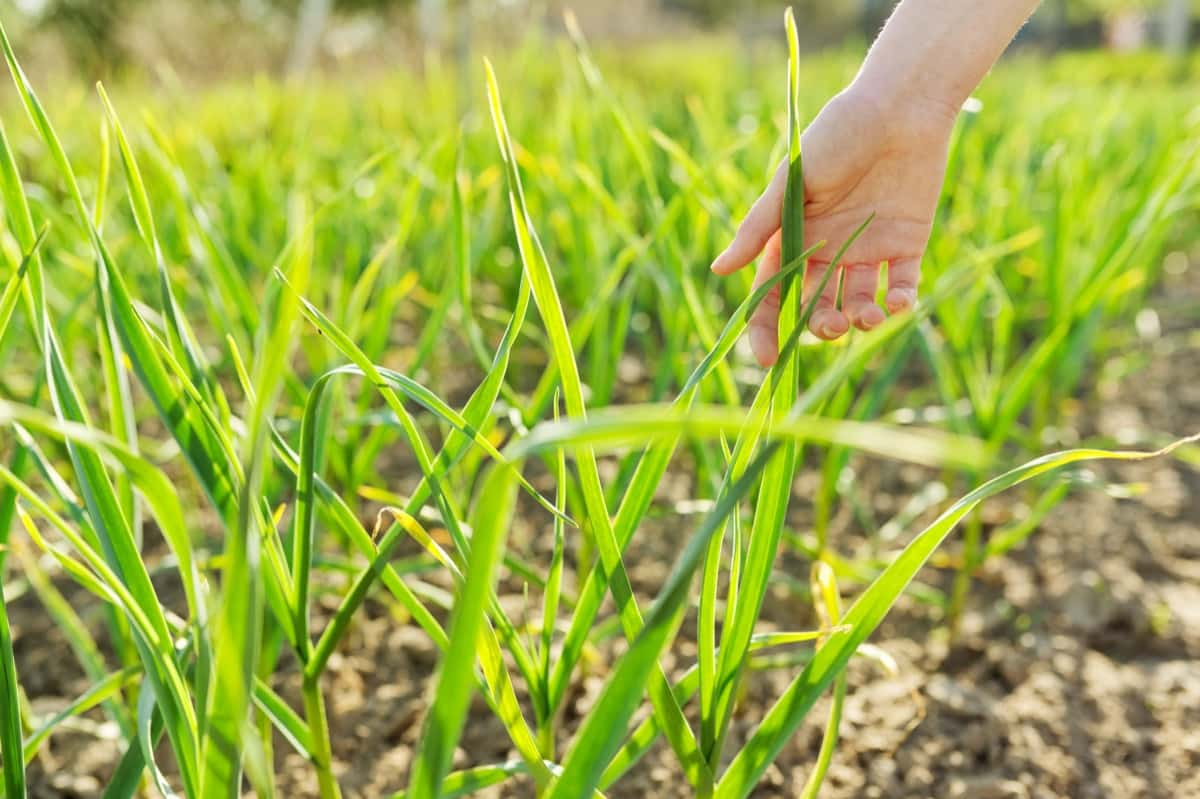
Essential Garlic Care Tips
- Weed Control: Ensure the area around your garlic remains weed-free, as garlic doesn’t compete well with weeds for nutrients.
- Proper Watering: In dry spring weather, water your garlic deeply every eight to 10 days, but reduce watering in June as the bulbs develop.
- Checking for Maturity: Begin checking for mature cloves by the end of June. Look for plump cloves with thick, dry, papery skin. The green tops of garlic do not wither like other Alliums when ready.
- Curing and Storage: Cure the harvested bulbs in a shaded, warm, dry, and airy location for about a week. Store garlic in a cool, dry, dark area, avoiding refrigeration as it promotes sprouting.
Best Organic Garlic Fertilizer for Optimal Growth
Organic fertilizers offer a natural and sustainable approach to nourishing garlic crops while promoting soil health. The best options are well-decomposed compost, aged manure, and fish emulsion. These organic choices enrich the soil with essential nutrients, improve soil structure, and foster beneficial microbial activity.
Compost, in particular, releases nutrients slowly, providing a steady supply for the garlic plants throughout their growth cycle. Organic garlic fertilizers contribute to robust plant growth and ensure the harvested bulbs are free from harmful chemical residues, making them safe for consumption.
How to Choose the Right Fertilizer for Garlic Cultivation
Selecting the appropriate fertilizer for garlic cultivation involves considering the plant’s nutrient requirements and the soil’s nutrient composition. Garlic is a heavy feeder, necessitating a nitrogen-rich fertilizer to support vegetative growth. Look for a balanced NPK (nitrogen, phosphorus, and potassium) ratio with a higher nitrogen content (e.g., 10-5-5 or 20-10-10). Additionally, choose a fertilizer with secondary nutrients like calcium and magnesium to fortify garlic bulbs and enhance overall plant health. Regular soil testing is vital to identify deficiencies and tailor the fertilizer application accordingly.
Recommended NPK Ratio for Garlic Fertilization
Garlic plants need 16-6-4 NPK fertilizer. This means the fertilizer is high in nitrogen, which boosts plant output and bulb quality. An ideal NPK ratio for garlic is 10-10-10 or 15-10-10, where the first number represents the percentage of nitrogen, the second is phosphorus, and the third is potassium. Nitrogen promotes leafy growth, while phosphorus aids root development and flower formation. Potassium contributes to overall plant vigor and disease resistance.
In case you missed it: Hydroponic Garlic Farming, Planting, Growing Procedure
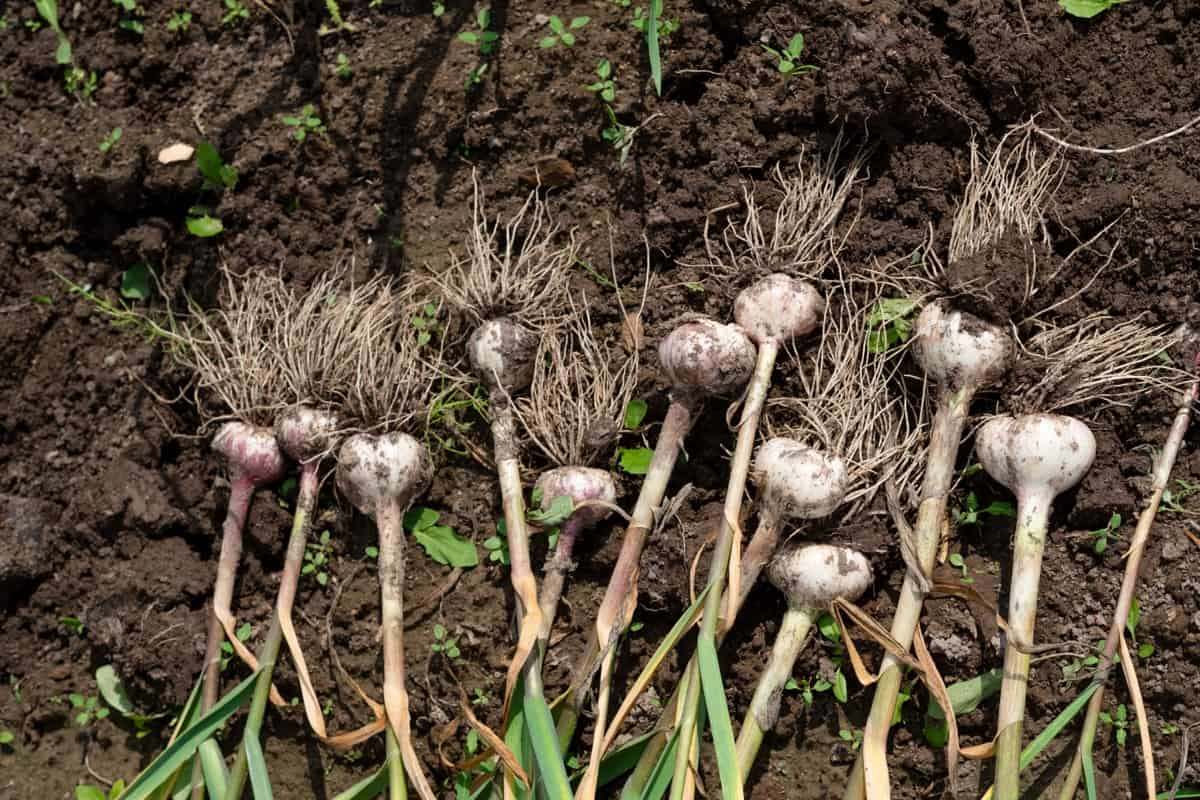
Understanding the Nutrient Needs of Garlic Plants
Garlic plants require a mix of essential nutrients for their optimal development. The primary nutrients (nitrogen, phosphorus, and potassium) also need secondary nutrients like calcium, magnesium, and sulfur. Calcium is vital in maintaining cell structure, while magnesium is essential for chlorophyll production. Sulfur contributes to forming amino acids, which are critical for protein synthesis. Additionally, garlic benefits from various micronutrients such as iron, manganese, zinc, and boron, facilitating enzyme activity and various metabolic processes.
Importance of Soil Ph in Garlic Fertilization
Garlic thrives in slightly acidic to neutral soils with a pH value of 5.5 to 7.2. In this pH range, essential nutrients are readily accessible to the plants. Monitoring and adjusting soil pH can prevent nutrient deficiencies and maximize fertilizer efficiency. When soil pH deviates from the ideal range, certain nutrients may become locked in the soil and unavailable for uptake, leading to stunted growth and diminished yields.
Preparing the Ground for Garlic Fertilization
Before planting garlic bulbs, enrich the soil with well-rotted manure or homemade compost. This practice enhances soil fertility and improves water retention and drainage, critical for garlic’s well-being. Avoid using fresh or untreated manure, as it can burn plant roots. If compost is unavailable, use a slow-release fertilizer during fall planting to provide a balanced nutrient supply.
Understanding the Growing Cycle of Garlic
The timing for garlic planting depends on the variety you choose. Hardneck and softneck garlic have different planting periods. Always use certified disease-free seed garlic for planting to avoid introducing harmful pathogens to your garden.
Early Application for Optimal Growth
Applying fertilizer early in the garlic growing cycle sets the stage for a successful crop. This initial application promotes healthy root development and maximizes bulb growth in the spring. Using compost and fertilizer before planting ensures a robust start for your garlic plants.
Nitrogen-Rich Fertilization for Fall-Planted Garlic
Garlic bulbs planted in the fall require additional Fertilization come spring with a nitrogen-rich fertilizer. You can side-dress the crop by digging a small trench alongside the garlic row and applying the fertilizer or broadcast the fertilizer over the entire bed. Water well after Fertilization to ensure nutrient uptake.
Transition to High Potassium Fertilizer
Around 45-60 days later, as the bulbs swell, they switch from high-nitrogen to high-potassium fertilizer. Nitrogen promotes foliage growth and may negatively impact bulb size, while potassium is vital for bulb enlargement. Applying sulfate of potash every six weeks provides the necessary nutrients for successful garlic growth.
In case you missed it: Polyhouse Garlic Farming (Vellulli), Cultivation Practices
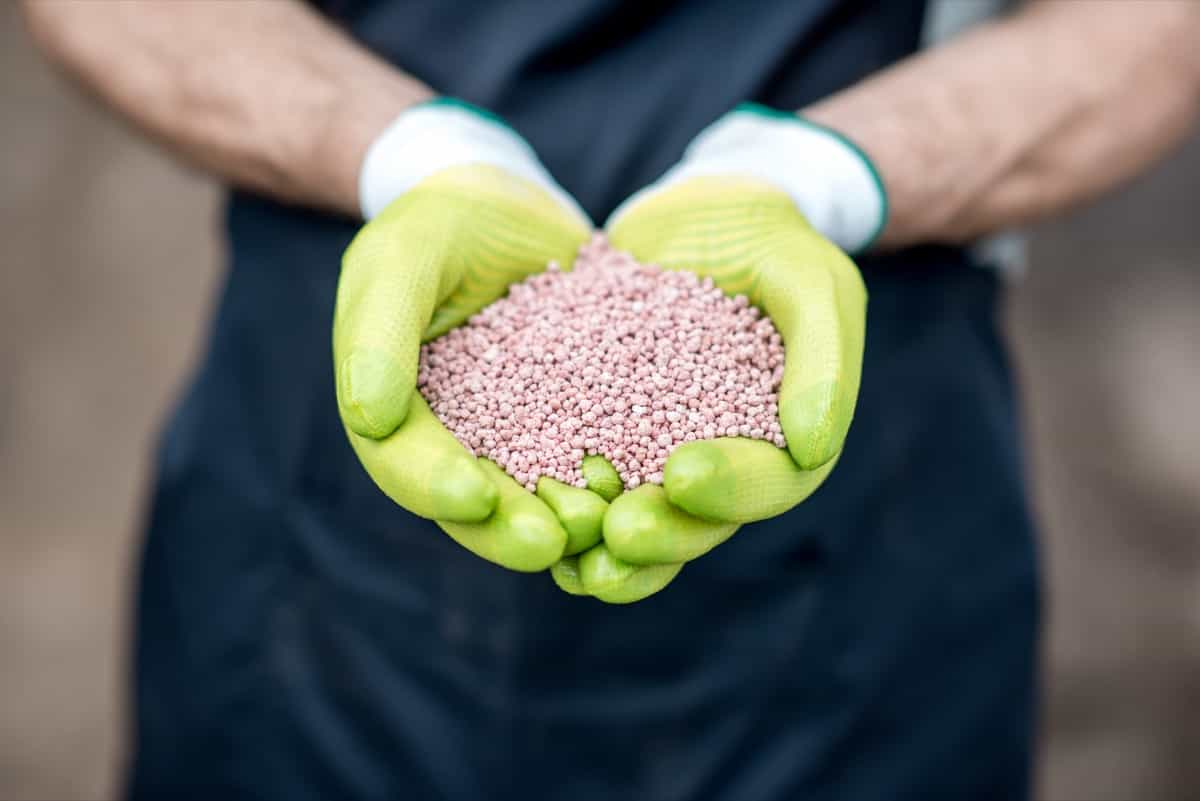
Cessation of Fertilization Before Harvest
Stop watering and feeding garlic in the last few weeks before harvest. Continued watering at this stage can increase the risk of bulb rot, affecting storage quality. Ceasing Fertilization allows the plant to focus on bulb development and enhances the garlic’s storing capabilities.
Best Fertilizers for Garlic
Well-rotted manure or garden compost, preferably certified organic, provides a balanced nutrient supply over time and is ideal for garlic’s long growing cycle. A slow-release fertilizer during fall planting can serve as a suitable alternative. High-nitrogen fertilizers, such as chicken manure pellets, fish fertilizers, and seaweed extract, are beneficial for spring application. Consider using blood meal or poultry manure-based fertilizers for an extra nitrogen boost. High-potassium feeds, like tomato fertilizer or comfrey fertilizer, are suitable for late spring and summer application to enhance bulb development.
- Is Chicken Manure a Good Fertilizer for Garlic? Chicken manure is an best source of nitrogen and other essential nutrients. Use well-rotted pellets to avoid introducing harmful bacteria.
- Is Bone Meal Good for Fertilizing Garlic? Bone meal is high in phosphorus, suitable for flowering plants, but garlic rarely requires added phosphorus unless there’s a deficiency.
- Are Coffee Grounds Good for Garlic? Coffee grounds are nitrogen-rich and can be used to feed garlic. They also act as a natural deterrent against pests and fungal diseases.
When and How Often to Fertilize Garlic Crops
For fall-planted garlic, apply fertilizer in the spring when new growth begins. Side-dress the plants with a balanced organic fertilizer, ensuring they are placed a few inches away from the stem to avoid burning. Repeat this process every three to four weeks until mid-May, when the bulbs start to swell. Cease Fertilization with nitrogen-rich products after May, as excessive nitrogen at this stage can hinder bulb development.
Organic vs. Synthetic Fertilizers for Garlic Cultivation
Organic and synthetic fertilizers depend on personal preferences, environmental concerns, and soil health objectives. Organic fertilizers, derived from natural sources, improve soil structure, foster beneficial microbial activity, and release nutrients slowly, promoting sustainable agriculture.
On the other hand, synthetic fertilizers deliver nutrients quickly but may cause chemical imbalances and harm beneficial soil organisms if overused. Organic options are recommended for garlic cultivation, as they produce chemical-free, flavorful bulbs and contribute to long-term soil fertility.
In case you missed it: Garlic Cultivation Income; Cost; Profit; Project Report
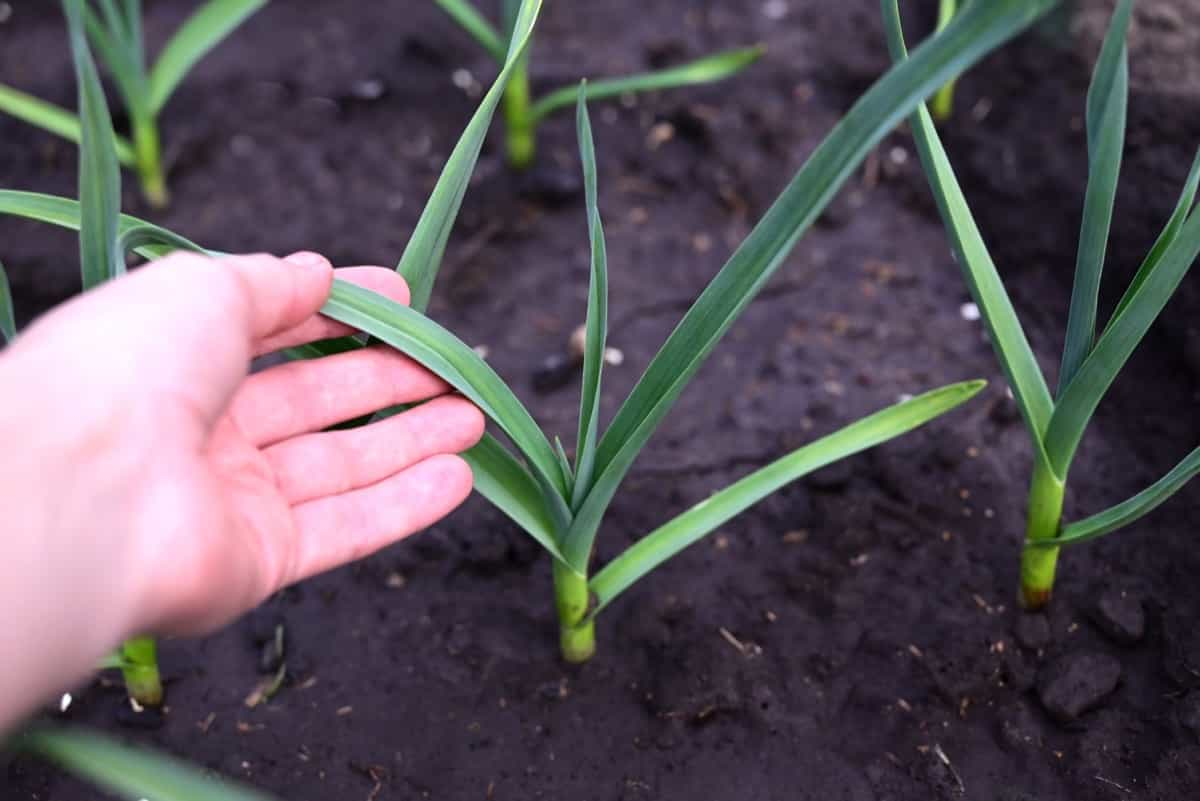
The Role of Micronutrients in Garlic Fertilization
Though required in smaller quantities, micronutrients play a crucial role in garlic growth and development. Iron aids chlorophyll production and enzyme activity, while manganese supports photosynthesis and nitrogen metabolism. Zinc contributes to hormone regulation and enzyme function, promoting overall plant health. Boron is vital for pollen germination and fruit development. Properly supplementing garlic with these micronutrients helps prevent deficiency-related disorders.
Fertilizer Application Methods for Garlic Farming
For smaller gardens, side dressing is an effective technique where the fertilizer is applied along the sides of the plant rows. Broadcast and Foliar spray application suits larger fields, where fertilizers are evenly spread across the planting area. Another method involves using a soaker hose to apply liquid fertilizer directly to the soil, ensuring efficient nutrient uptake by the garlic roots. Precision in fertilizer application methods prevents wastage and promotes resource-efficient farming practices.
Common Nutrient Deficiencies in Garlic Plants
Yellowing leaves with green veins indicates a lack of magnesium while yellowing between veins suggests an iron deficiency. Pale green leaves and slow growth may result from nitrogen deficiency. A shortage of potassium is evident through yellowing leaf edges and weak stems. Boron deficiency leads to distorted bulb growth, and zinc deficiency results in short, narrow leaves.
Effect of Excessive Fertilizer on Garlic Crops
Over-fertilization, particularly with nitrogen-rich products, can lead to excessive vegetative growth at the expense of bulb development. This results in smaller, less flavorful garlic bulbs. Moreover, excessive fertilizer application may cause nutrient imbalances, leading to toxicities or deficiencies of certain elements. Proper dosing and adherence to recommended guidelines help maintain a healthy nutrient balance and ensure the garlic plants receive nourishment.
Using Compost as a Natural Garlic Fertilizer
Compost, an organic fertilizer, provides benefits for garlic cultivation. It enhances soil structure, improves water retention, and encourages beneficial microbial activity. Compost releases nutrients slowly, providing a steady supply throughout the garlic growing season. It also helps maintain soil pH levels and reduces the risk of nutrient leaching. By mixing compost in the soil before planting and using it as a top dressing during the growing season, garlic farmers can ensure their crops receive a rich blend of nutrients for optimal growth and superior bulb development.
Fertilizer Recommendations for Different Garlic Varieties
For hardneck garlic varieties, which produce fewer but larger cloves, a balanced NPK ratio of 10-10-10 or 20-20-20 is recommended during the early growth stages. As the bulbs swell, shifting to a high-potassium fertilizer like sulfate of potash is advised. On the other hand, softneck garlic varieties benefit from higher nitrogen levels to support their multiple, softer stem growth. Nitrogen-rich fertilizers, such as chicken manure pellets or fish fertilizers, can be applied in the spring to encourage healthy foliage and bulb development.
In case you missed it: The Sustainable Solution: Bio-composting with Agricultural By-products
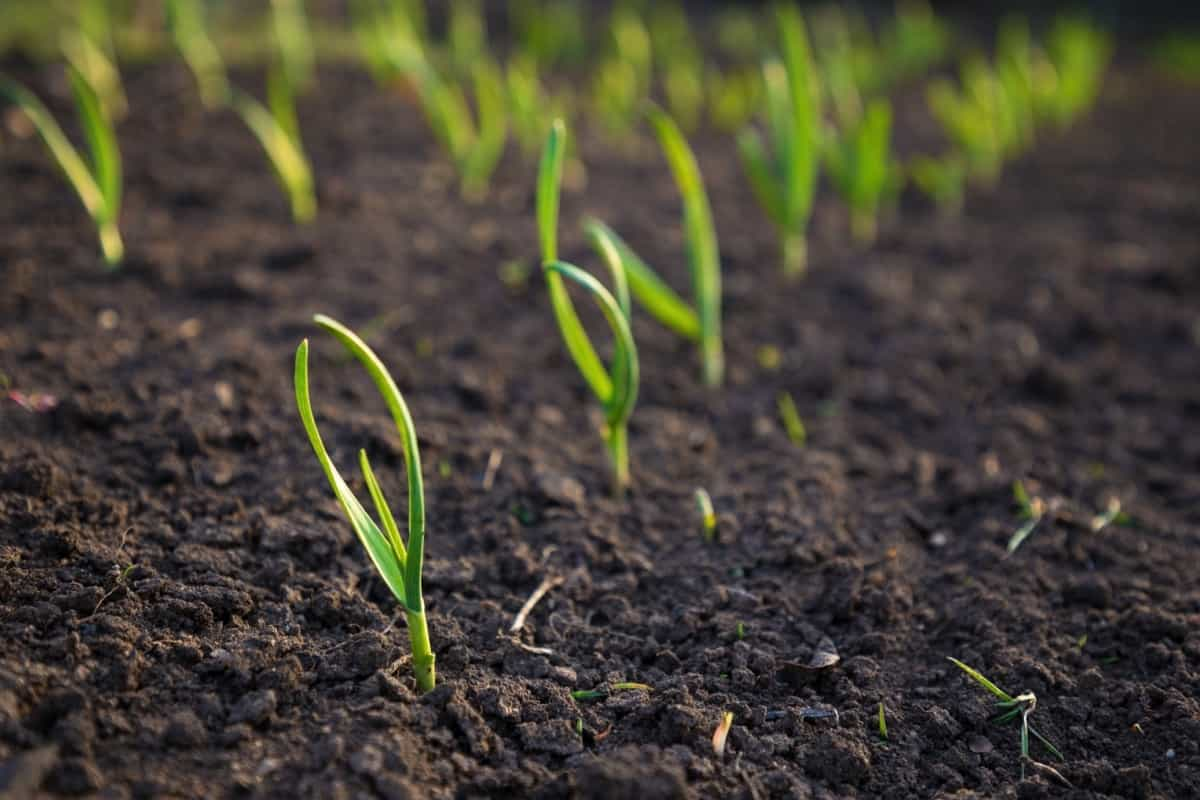
Balancing Nitrogen Levels in Garlic Fertilization
While nitrogen is crucial for promoting robust garlic growth, maintaining a proper balance is essential. Too much nitrogen can cause to excessive vegetative growth and hinder bulb formation. On the other hand, insufficient nitrogen results in weak plants with reduced yield.
Striking the right balance involves monitoring plant growth and adjusting the fertilizer application accordingly. By providing an adequate but not excessive amount of nitrogen, garlic farmers can encourage optimal leafy development and ensure the energy is directed toward bulb formation, resulting in high-quality, well-sized garlic bulbs.
Optimizing Garlic Bulb Size with Proper Fertilization
Ensuring adequate nutrient supply during the plant’s early stages of growth sets the foundation for robust bulb development. Providing sufficient potassium aids in bulb enlargement, while balanced nitrogen levels promote optimal leafy growth. Adequate calcium ensures strong cell structure and helps prevent disorders like tip burn. Additionally, timely Fertilization based on the plant’s growth stage, attentive care, and appropriate irrigation contribute to bigger, healthier garlic bulbs that will delight both home gardeners and commercial growers alike.
Conclusion
Timely and appropriate fertilization, using high-nitrogen for early growth and high-potassium as bulbs swell, ensures robust plant development, flavorful bulbs, and reduced pest and disease risks. Apply the right nutrients at the right time for optimal results.
- How to Build a Low-budget Goat Shed: Cheap Ideas and Tips
- Goat Farming Training Programs in India: A Beginner’s Guide
- Types of Pesticides Used in Agriculture: A Beginner’s Guide
- Economical Aquaculture: A Guide to Low-Budget Fish Farming
- 15 Common Planting Errors That Can Doom Your Fruit Trees
- How to Make Houseplants Bushy: Effective Tips and Ideas
- Innovative Strategies for Boosting Coconut Pollination and Yield
- Pollination Strategies for Maximum Pumpkin Yield
- The Complete Guide to Chicken Fattening: Strategies for Maximum Growth
- Natural Solutions for Tulip Problems: 100% Effective Remedies for Leaf and Bulb-Related Issues
- Revolutionizing Citrus Preservation: Towards a Healthier, Greener Future
- Natural Solutions for Peony Leaf and Flower Problems: 100% Effective Remedies
- Maximizing Profits with Avocado Contract Farming in India: A Comprehensive Guide
- Natural Solutions for Hydrangea Problems: 100% Effective Remedies for Leaf and Flowers
- The Ultimate Guide to Choosing the Perfect Foliage Friend: Bringing Life Indoors
- From Sunlight to Sustainability: 15 Ways to Use Solar Technology in Agriculture
- The Ultimate Guide to Dong Tao Chicken: Exploring from History to Raising
- The Eco-Friendly Makeover: How to Convert Your Unused Swimming Pool into a Fish Pond
- Mastering the Art of Delaware Chicken Farming: Essentials for Healthy Backyard Flocks
- 20 Best Homemade Fertilizers for Money Plant: DIY Recipes and Application Methods
- How to Craft a Comprehensive Free-Range Chicken Farming Business Plan
- Brighten Your Flock: Raising Easter Egger Chickens for Beauty and Bounty
- How to Optimize Your Poultry Egg Farm Business Plan with These Strategies
- Subsidy for Spirulina Cultivation: How Indian Government Schemes Encouraging Spirulina Farmers
- Ultimate Guide to Raising Dominique Chickens: Breeding, Feeding, Egg-Production, and Care
- Mastering the Art of Raising Jersey Giant Chickens: Care, Feeding, and More
- Ultimate Guide to Raising Legbar Chickens: Breeding, Farming Practices, Diet, Egg-Production
- How to Raise Welsummer Chickens: A Comprehensive Guide for Beginners
- How to Protect Indoor Plants in Winter: A Comprehensive Guide
- Ultimate Guide to Grow Bag Gardening: Tips, Tricks, and Planting Ideas for Urban Gardeners
- Guide to Lotus Cultivation: How to Propagate, Plant, Grow, Care, Cost, and Profit
- Agriculture Drone Subsidy Scheme: Government Kisan Subsidy, License, and How to Apply Online
- Ultimate Guide to Raising Araucana Chickens: Breed Profile, Farming Economics, Diet, and Care
- Bringing Hydroponics to Classroom: Importance, Benefits of Learning for School Students
- Ultimate Guide to Raising Polish Chickens: Breed Profile, Farming Economics, Diet, and Care
- Ultimate Guide to Raising Australorp Chickens: Profile, Farming Economics, Egg Production, Diet, and Care